1.22 Teams
Technicians are allocated to Teams for the various support processes. For each Process (i.e., Incident, Problem, Change and Service Request) there must be at least one support Team.
Default Teams are assigned to specific Item Types. Support requests generated against an Item Type are then assigned to a Technician within the default support Team for that Process. The Team may be reassigned based on other options provided through the associated SLA(s) and Workflow(s).
Support Teams for Incident and Problem Management include escalation layers, and Technicians are assigned to each of these layers. Incidents and Problems follow the escalation path determined by the service level triggers assigned to the request. For a Technician to be able to edit a request, they must be a member of the assigned Team, although they do not need to be included in an escalation layer.
Service and Change Request Teams are built around the selected Workflow. Technicians are assigned to work groups and each State of the Workflow Lifecycle is associated with a selected work group. When a request moves to a next State, it is assigned to a Technician within the work group associated with that Workflow State. One or multiple levels of escalation can also be configured for the Workflow, which span the lifecycle of the Workflow the Service or Change Team are assigned.
A Service Portfolio Team can be configured in the system, assigning the Users who will manage the development, production and discontinuation of services offered to the organization.
Use this section to:
-
Create new Incident and Problem Teams with escalation layers
-
Create Service and Change Request Teams with workflow assignments

1.22.1 Unknown Team
By default the system includes the system Team, Unknown, within the Teams List. This is the Team used by the application for Incidents created via email. It can be configured to use the system email address or an email account that is an alias for the main system account and Technicians can be assigned like any other Incident Team.
NOTE:The Unknown Team should NOT be re-named and will NOT appear in any other Teams lists throughout the application, i.e., when assigning a Team to an Item or Item Type.
1.22.2 Creating an Incident or Problem Team
To create an Incident or Problem Team:
-
Select User>Teams
-
Click New
-
Enter the Team Name
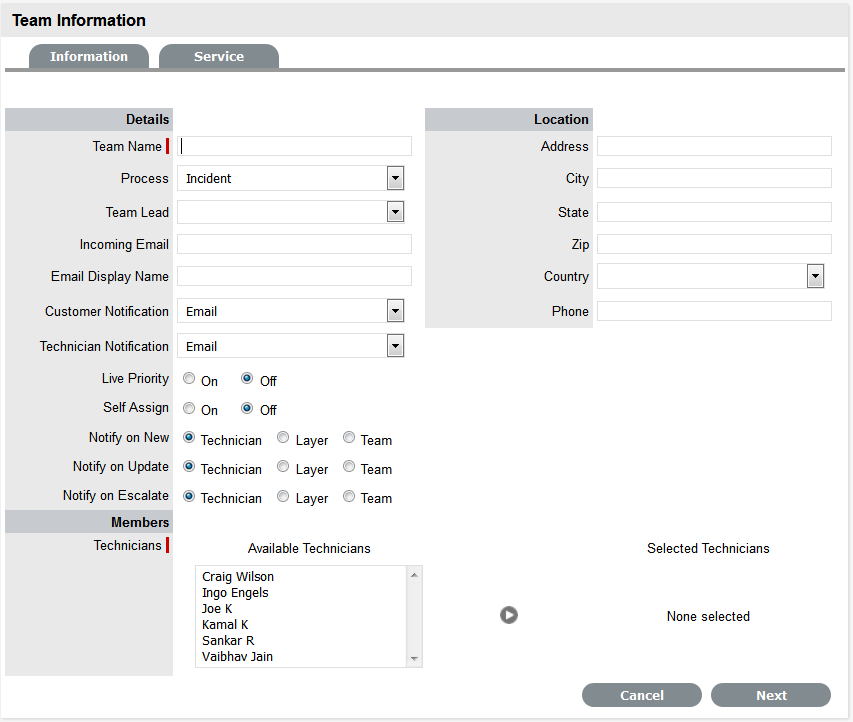
-
Select Incident or Problem Process
-
Enter the Team email address, if relevant
-
Define the Team options
-
Options
Description
Team
Enter the Team Name. (Required.)
Process
Indicates if the Team is to manage Incidents or Problems.
Team Lead
The Technician assigned to supervise the Team and its activities. Options are visible when the Technicians have been assigned to the Team.
Incoming Email
Enter a specific Email Address for the Team,which allows Customers to use directly. This address will need to be configured as an alias to the system support address on the Email Server. See: Email Polling & Request Creation.
Email Display Name
If desired, enter a name for the Team that will be used in the From address for email responses sent by members of the Team.
Customer Notification
Sets the default notification method applied to requests for Customer correspondence, when requests are assigned to this Team.
The Customer Defined option, derives the method of notification from the setting within the Customer's Profile or Account Information tab.
Technician Notification
Sets the default notification method applied to requests for Technician correspondence, when requests are assigned to this Team.
Live Priority
Routes requests to Technicians who belong to the Team and logged into the system.
Self Assign
When enabled, requests created by a Technician will automatically be assigned to that Technician.
Notify on New
Determines who is informed about the creation of a new request.
Technician - notifies only the Technician assigned to the request.(This is the default setting.)
Layer - notifies all members in Layer One of the Team assigned to the request.
Select Team - notifies all members of the Team.
Notify on Update
Determines who is informed when a request is updated.
Technician - notifies only the Technician assigned to the request.(This is the default setting.)
Layer - notifies all members in Layer One of the Team assigned to the request.
Select Team - notifies all members of the Team.
Notify on Escalate
Determines who is informed when a request is escalated.
Technician - notifies only the Technician assigned to the request.(This is the default setting.)
Layer - notifies all members in Layer One of the Team assigned to the request.
Select Team - notifies all members of the Team.
Incident/Problem Queue
Allows the Team to use a holding bay for Incidents/Problems that are received via email or the Customer Portal. (This option is visible if it has been enabled by the Administrator.)
If the Team has only one Technician assigned to Layer One of Escalation, new Incidents are automatically assigned to that Technician and that Technician is notified of the new Incident assignment.
If the Team has multiple Technicians assigned to Layer One of Escalation, the new Incident is placed in the Queue (i.e., it is assigned to the System User) and all members of the Team are notified that a new Incident has been assigned to the Incident Queue. See: Queues.
Queue Visibility
When the Incident Queue is enabled, the option can be refined to allow the Queue to be available for assigned Workflow entry points, or all stages of the assigned Workflow. If All States is enabled, Users can move requests back to the Queue throughout the request lifecycle. See: Queues.
Edit Assign
When set to Yes and a request assigned to the System User (i.e., Queue) is opened in Edit Mode, the system will automatically assign the request to the User editing the request if they are in the Escalation Layer associated with the request.
Close Assign
When set to Yes and a request assigned to the System User (i.e., Queue) is moved to an Exit State of the Workflow, the system will automatically assign the request to the User who prompted the close action.
-
Complete the Team Location details, if required
-
Select Technicians from the Available Technicians list
Highlight Technician names within the Available Technicians list and click the arrow icon to move the Users to the Selected Technicians list.
-
Click Next
The Service Screen displays all Available OLAs and Workflows
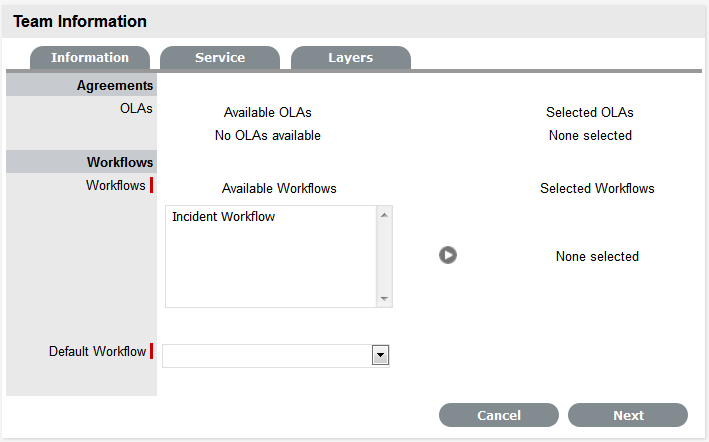
-
Assign the relevant OLAs within Available OLAs list (Optional)
HIghlight the Team Name and click the arrow icon to move an OLA to Selected OLAs list. Assigning an OLA to the Team ensures the Team's details will be selectable when the assigned OLA is associated with a Workflow State.
-
Assign the relevant Workflows within the Available Workflow list
Highlight the Workflow Name and click the arrow icon to move the Workflow into the Selected Workflows list. Assigning Workflows to the Team ensures the Team is displayed as an option within the request Summary tab when the associated Workflows are assigned to a request.
-
If more than one Workflow is assigned, select a Default Workflow form the drop-down list
-
Select Next
The Escalation screen appears. This allows Escalation Layers and Technician assignment to be configured.
-
To edit the Default Layer, select the link
-
Move Technicians between the Available and Selected boxes and amend the Layer Name, if required
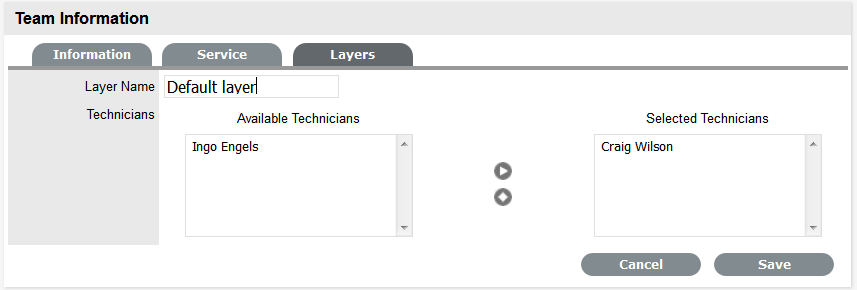
-
Click Save
-
To create additional Escalation Layers, select New
By default the Team Lead will always be assigned to the Escalation Layer upon creation.
-
Click on the Layer link to edit the Technician assignment and Save
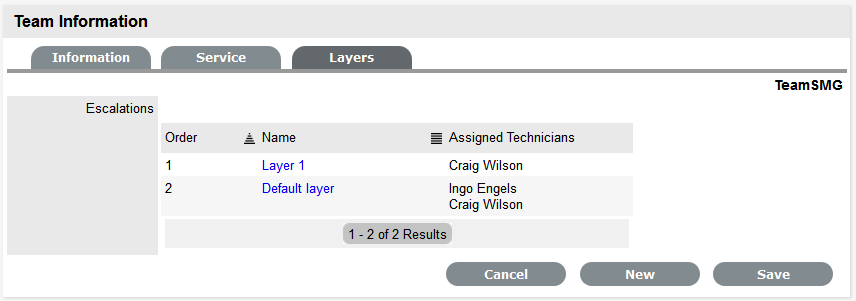
-
To delete a Layer, select the Layer Name
-
Click the Delete button and Save.
1.22.3 Creating and Configuring Additional Escalation Layers
Additional escalation levels can be created, if required. The order of the escalation pathway is determined by the order of creation. That is, layer one is entry level support, layer two is the next level of support and so on.
-
Select Team Information>Layers
-
Click Edit to display the New button
The Technicians who are assigned to the Team are displayed in the Available Technicians list
-
Add and/or remove Technicians from the Escalation Layer Members list
-
Click Save.

1.22.4 Editing an Escalation Layer
To edit an Escalation Layer with the Team Information screen in Edit mode:
-
Select the Layers tab
-
Click on the Layer name hyperlink
The list of available and assigned Technicians is displayed.
-
Remove and add Technicians, as required
Highlight the User Names within the relevant list and click the arrow to move the User to the required list.
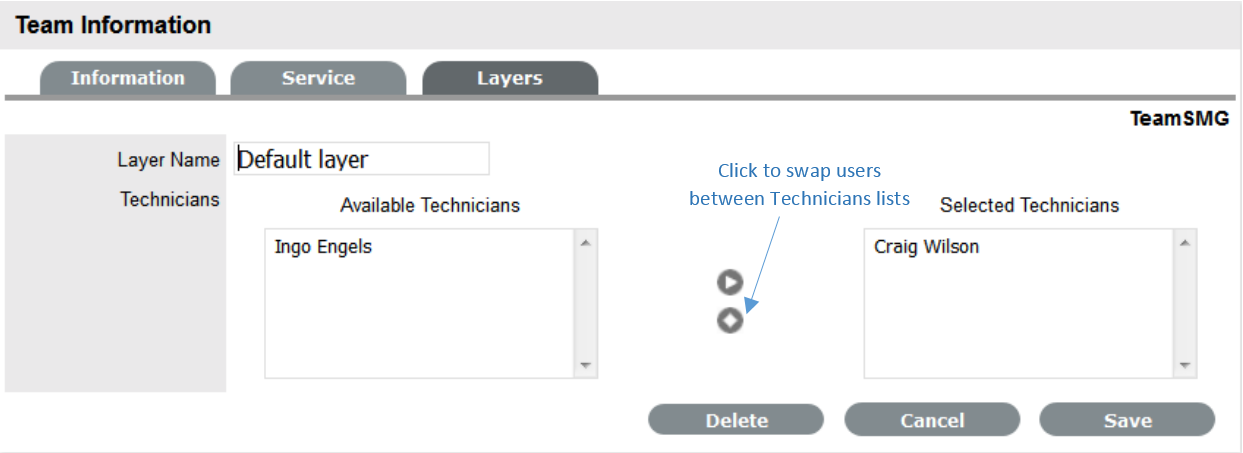
-
Select Save.
1.22.5 Configuration of Escalation Layers
The following process is recommended for configuring Escalation Layers. Level one should contain the majority of Available Technicians who have been assigned to the Team. A smaller but more experienced group should be assigned to the second level. An even smaller and more experienced group should be assigned to the third level and so on until the final level of escalation. Ideally, the last layer should contain only the Team’s Lead Technician.
There are no constraints to prevent individual Technicians from being assigned to more than one level. However, for a Technician to be able to edit a request they must be a member of the assigned Team, although they do not need to be included in an escalation layer.
To remove a User from a Team:
-
In the User tab, click Users
The User Information screen appears.
-
Click on the name of the User
-
Select the Team tab
-
Click on Edit
The Remove button is displayed.
-
Select the checkbox to the left of the Team Name
Multiple check boxes can be selected.
-
Select Remove to delete the User from a Team
The User Name is removed from the Team.
-
Click Done.